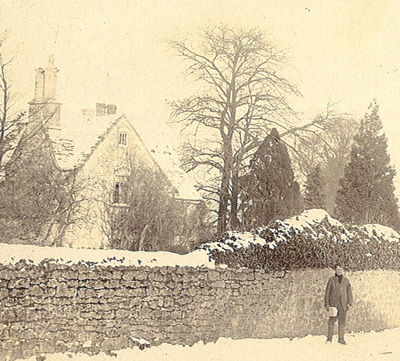An Historic Wiltshire farmhouse with a distinguished past
This 17th century Manor Farmhouse in the village of Blunsdon, Wiltshire, has passed through the hands of some distinguished owners

The Manor Farmhouse features an original square-plan Jacobean staircase, stone fireplaces and has remained the home of gentleman farmers for almost 400 years. The house, built in the early 1600s and for sale with Chesterton Humberts, is Grade II* listed and sits within the small village of Blunsdon in Wiltshire. When looking at the exterior of the house you can easily see how it has actually changed very little since it was first built at the time James I came to the throne. However, although it has remained home to gentleman farmers, Manor Farmhouse has had many prestigious owners.
The manor of Blunsdon can be traced back to the Dissolution of Monasteries when Henry VIII granted the land, formerly attached to Godstow Abbey near Oxford, to John Brydges, Lord Chandos. The farmhouse was built in the very early years of the 17th century, although it is thought it could have been built at the end of the 16th century. The first resident was yeoman farmer, Richard Lombell. At this time the lord of the manor was Edward Goddard, son of Richard Goddard, lord of the manor of Swindon.
Edward Goddard did not retain the manor of Blunsdon for long, as by 1606 it had passed to Thomas Phillipe. Throughout the 17th century the owners of the manor changed a number of times, while documents do not name the occupants, it is understood that those living in the Manor Farmhouse were gentleman farmers working the land and playing an active role in the village of Blunsdon.
However, by the turn of the 19th century the manor had been sold to Henry Herbert, 1st Earl of Carnarvon and Baron Porchester. The Earl of Carnarvon represented Wilton in the House of Commons from 1768 to 1780, was admitted to the Privy Council in 1806 and was Master of the Horse in 1806-7. The manor then passed to the Earl's eldest son, Henry George Herbert, 2nd Earl of Carnarvon, but he mortgaged part of the estate to James Earl of Rosslyn.
James St Clair-Erskine, 2nd Earl of Rosslyn was assistant Adjutant-General in Ireland in 1782 and rose to Adjutant-General in 1793. The 2nd Earl of Rosslyn was promoted to Colonel and Aide-de-Camp to George III in 1795 and became General in 1814. The 2nd Earl of Rosslyn held further positions of importance, becoming Lord Privy Seal in 1829-30 under the Duke of Wellington and Lord President of the Council
under Sir Robert Peel in 1834-5.

The Manor Farmhouse in 1905
Sign up for the Country Life Newsletter
Exquisite houses, the beauty of Nature, and how to get the most from your life, straight to your inbox.
While the owners of the manor held their positions and climbed the ranks of politics and society, the occupants of Manor Farmhouse continued to be well respected gentleman farmers. During the early 19th century the house was the home of George Edmunds and his family. The Edmunds family continued at the farmhouse throughout the 19th century and the 1851 census shows the farm had passed to John Edmunds, who was only 27 years old and farming 180 acres and employing 15 labourers.
The farmhouse continued in the Edmunds family, with John's mother-in-law, Hannah Keylock, living in the house into the early 1880s. However, by the late 1880s Manor Farmhouse had become the home of Joseph and Mary Smith and by 1888 Joseph Smith had purchased the freehold of the farm. By the turn of the 20th century Manor Farmhouse was still the home of Joseph and Mary, with the 1901 census showing Joseph, aged 75 and Mary, aged 78 were in the house with one live-in servant.
By 1905 Joseph Smith sold the farmhouse and land to neighbouring landowner, Henry Cecil Sutton, esq., who at that time was living in nearby Holdcroft House. Henry Sutton placed his bailiff, John Francis Knapp, in the house and the 1911 census shows John Knapp in the house with his wife Sarah. The Knapp family remained in the house until after World War I, when it became the home of George and Dorothy Heigham. However, in 1944 the entire Holdcroft Estate was sold, including Manor Farmhouse, at the time described as a "charming and typical old Wiltshire residence".
The late 20th century saw many changes at Manor Farmhouse, as well as in the village of Blunsdon. A number of residents spent time restoring and renovating the house, including the Gallie family in the 1970s, who uncovered the stone fireplaces. Manor Farmhouse has fortunately retained many historic features giving today's owner a glimpse of the 17th century house that was first home to Richard Lowell at the time Elizabeth I was still the Queen of England.
* More details on Manor Farmhouse
* Read the full history of the house on Melanie's Blog The House Historian
Country Life is unlike any other magazine: the only glossy weekly on the newsstand and the only magazine that has been guest-edited by HRH The King not once, but twice. It is a celebration of modern rural life and all its diverse joys and pleasures — that was first published in Queen Victoria's Diamond Jubilee year. Our eclectic mixture of witty and informative content — from the most up-to-date property news and commentary and a coveted glimpse inside some of the UK's best houses and gardens, to gardening, the arts and interior design, written by experts in their field — still cannot be found in print or online, anywhere else.
-
 ‘It had the air of an ex-rental, and that’s putting it politely’: How an antique dealer transformed a run-down Georgian house in Chatham Dockyards
‘It had the air of an ex-rental, and that’s putting it politely’: How an antique dealer transformed a run-down Georgian house in Chatham DockyardsAn antique dealer with an eye for colour has rescued an 18th-century house from years of neglect with the help of the team at Mylands.
By Arabella Youens Published
-
 You're having a giraffe: Country Life Quiz of the Day, April 25, 2025
You're having a giraffe: Country Life Quiz of the Day, April 25, 2025Friday's Quiz of the Day brings your opera, marathons and a Spanish landmark.
By Toby Keel Published
